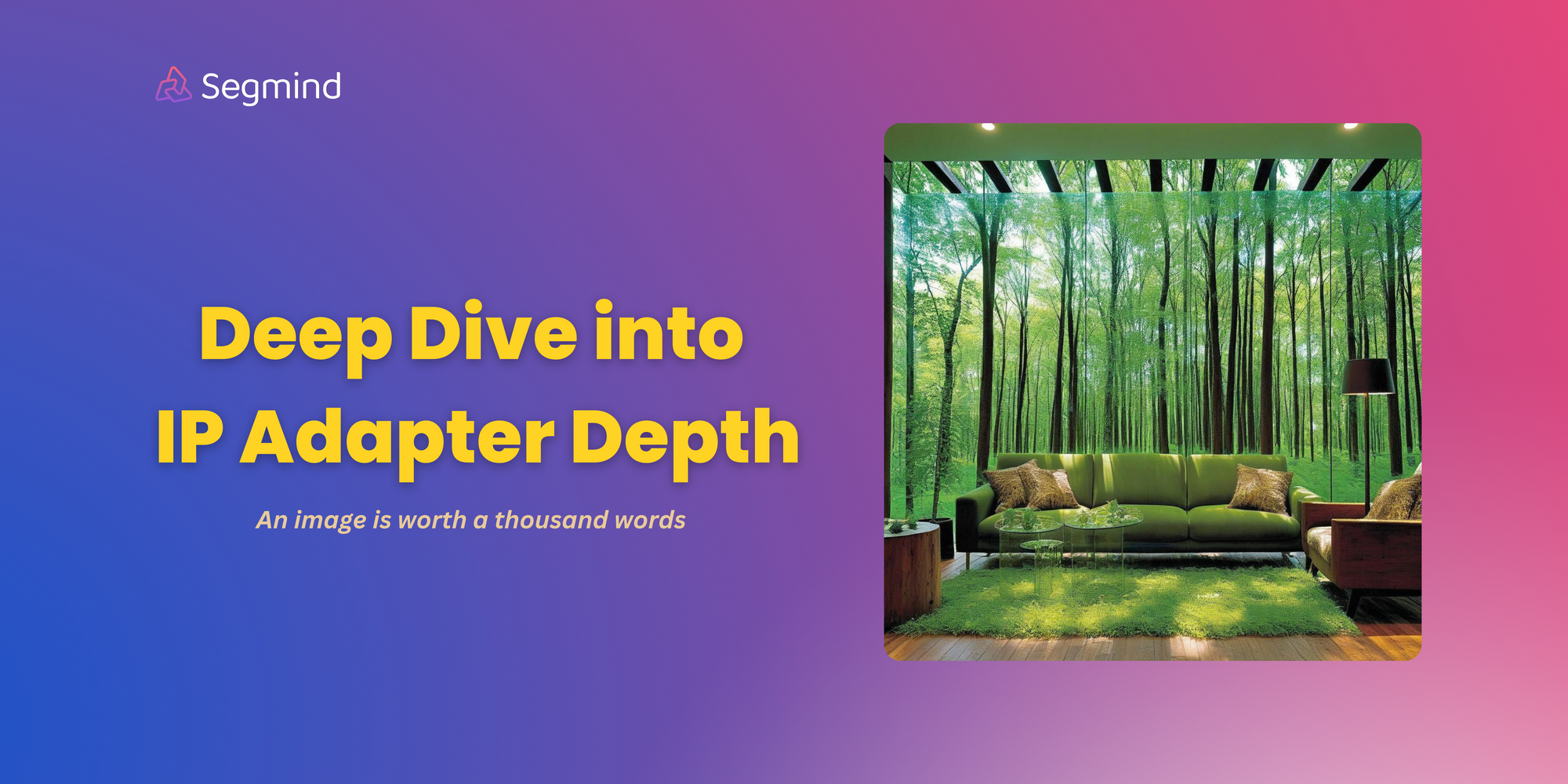IP-Adapter Depth XL: Model Deep Dive
A comprehensive guide to maximizing the potential of the IP Adapter XL Depth model in image transformation.

In this blog, we delve into the intricacies of Segmind's new model, the IP Adapter XL Depth Model. By seamlessly integrating the IP Adapter with the Depth Preprocessor, this model introduces a groundbreaking combination of depth perception and contextual understanding in the realm of image creation.
The synergy between these components significantly elevates the functionality of the SDXL framework, promising a distinctive approach to image transformation with enhanced depth and nuanced contextual insights.
Under the hood
Text-to-image models are awesome, but they can't read pictures yet. That's where IP-Adapter comes in, like a secret translator for your AI art bestie! It cracks the code of images, telling them how light dances and shapes talk to each other, in a language the model digs. But hey, one picture is worth a thousand words, right? So don't just whisper, scream your vision with an image prompt!
Now, let's delve into the mechanics of this process:
1. Image Encoder: Similar to an investigative neural network, it meticulously examines the image prompt pixel by pixel, extracting crucial elements such as shapes, textures, and color palettes. Essentially, it comprehends the visual narrative embedded in the image.
2. Adapted Modules: Envision these as translation bots, transforming the extracted image features into a format that the diffusion model can comprehend. Employing linear layers and non-linearities, they encode the visual information in a manner digestible for the model.

3. Decoupled Cross-Attention: This is the magic sauce! Instead of a single, mashed-up attention layer, IP-Adapter has separate cross-attention mechanisms for text and image features. This means the model attends to both prompts independently, then carefully blends their insights in a weighted fashion.
Now, the IP-Adapter welcomes a new ally to its artistic team: the Depth Preprocessor, a visionary who sees beyond the surface, revealing the hidden dimensions of the image.
4. Mapping the Image's Depth: The Depth Preprocessor delves into the image, crafting a detailed map of its three-dimensional structure. It measures the subtle variations in distance, revealing how objects recede into the background or project into the foreground.

5. Unlocking Spatial Intelligence: Armed with this depth map, the IP-Adapter gains a newfound understanding of the image's true 3D layout. It can now accurately perceive how objects interact in space, their relationships, and how they overlap. This spatial awareness empowers the model to create realistic 3D effects and place elements with precision.

Equipped with this spatial superpower, the IP-Adapter is ready to bring your creative vision to life. It can seamlessly blend your artistic desires with the image's inherent 3D character, opening up a world of possibilities for detailed and nuanced art.
So step aside, Van Gogh, because IP-Adapter Depth XL is here to paint the future, pixel by pixel, depth map by depth map .
A Hands-On Guide to Getting Started
Segmind's IP Adapter Depth model is now accessible at no cost. Head over to the platform and sign up to receive 100 free inferences every day! Let's go through the steps to get our hands on the model.
Prepare your Input Image
Your chosen image acts as a reference for the model to grasp the human body pose and generate features on top of it. In this guide, we'll use a picture of a living room as our input image.
Building the prompt
There are two prompts to create: the image prompt and the text prompt. The image prompt sets the scene for the final output image, while the text prompt refines and adds modifications to the base image.
Let's have a look at the results produced :

Adjusting the Advanced Settings
Let's explore advanced settings to enhance your experience, guiding you through the details for optimal results.
1. IP Adapter Scale
The IP Adapter Scale is crucial because it determines how strongly the prompt image influences the diffusion process in our original image. This parameter is like a specification that defines the scale at which visual information from the prompt image is mixed into the existing context. In simpler terms, it quantifies the level of influence the image prompt has on the final output, giving us precise control over how the diffusion process unfolds.

2. ControlNet Scale
The ControlNet Scale is like a volume knob that's super important. It decides how much the ControlNet preprocessors, like Depth, should affect the way the final image looks. In simple terms, it's like finding the right balance between the special effects added by ControlNet and the original image. Adjusting this scale helps control how strong or subtle those effects are in the end.

3. Inference Steps
It indicates the number of denoising steps, where the model iteratively refines an image generated from random noise derived from a text input. With each step, the model removes some noise, leading to a progressive enhancement in the quality of the generated image. A greater number of steps correlates with the production of higher-quality images.
Opting for more denoising steps also comes at the cost of slower and more expensive inference. While a larger number of denoising steps improves output quality, it's crucial to find a balance that meets specific needs.

4. Seed
The seed is like a kickstart for the random number generator, which sets up how the model begins its training or creating process. Picking a particular seed makes sure that every time you run it, the model starts in the same way, giving you results that are consistent and easy to predict.
Code Unleashed
Segmind offers serverless API to leverage its models. Obtain your unique API key from the Segmind console for integration into various workflows using languages such as Bash, Python, and JavaScript. To explore the docs, head over to IP Adapter Depth API.
We will use Python for this guide. First, Let's define the libraries that will help us interact with the API and process the images.

Now, let's define our IP Adapter Depth Url and API key, which will give access to Segmind's models. We will also define a toB64 utility function which will help us to read image files and convert them into proper format which we can use to build the request payload.

Now that we've got the initial steps sorted, it's time to create a prompt for our image, define the desired parameter configurations, and assemble the request payload for the API.

Now that our request payload is set, it's time to send a request to the API endpoint and retrieve our generated image. Additionally, we'll resize the image to suit our workflow requirements, ensuring it fits seamlessly into our next steps.

Here's our final result! This module can be easily integrated further in your workflows in any language.

Summary
Segmind's IP Adapter Depth XL Model introduces a groundbreaking approach to text-to-image conversion. Operating akin to a skilled artist, it decodes both textual input and visual intricacies. The Depth Preprocessor meticulously outlines the image's structure, incorporating depth maps for added dimensionality. Simultaneously, the IP Adapter interprets contextual nuances, enriching the diffusion model.
Eager to experience the magic firsthand? The Segmind platform invites you to directly explore its capabilities, enabling experimentation with various parameters to observe their impact on your creations. For those seeking a more structured workflow, a Colab file is available, providing a guided path to unleash your creative potential.

